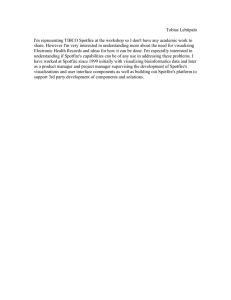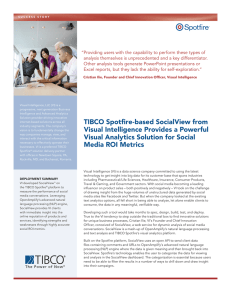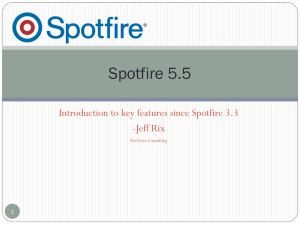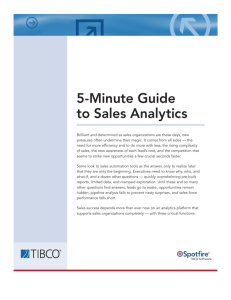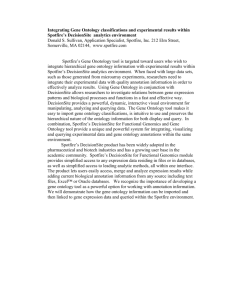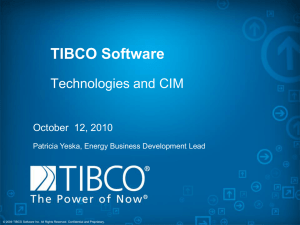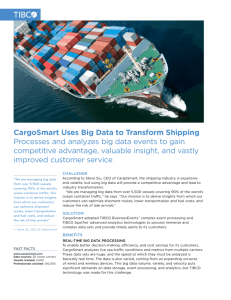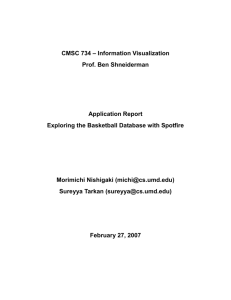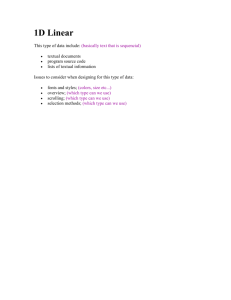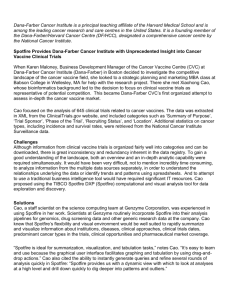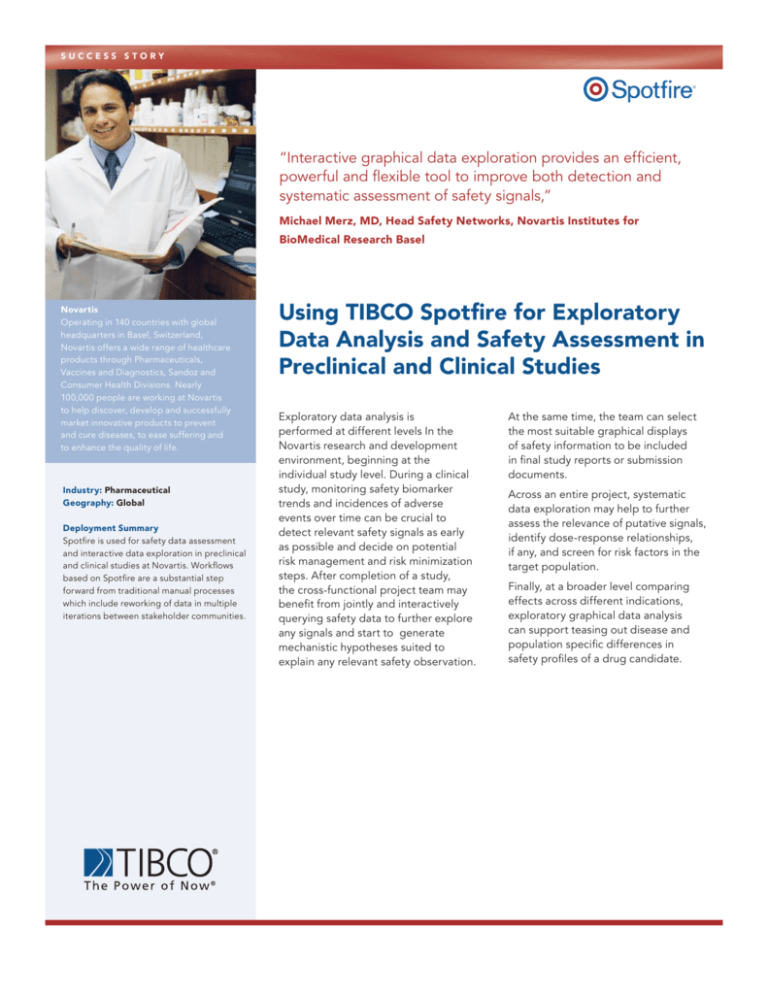
S uccess sto r y
“Interactive graphical data exploration provides an efficient,
powerful and flexible tool to improve both detection and
systematic assessment of safety signals,”
Michael Merz, MD, Head Safety Networks, Novartis Institutes for
BioMedical Research Basel
Novartis
Operating in 140 countries with global
headquarters in Basel, Switzerland,
Novartis offers a wide range of healthcare
products through Pharmaceuticals,
Vaccines and Diagnostics, Sandoz and
Consumer Health Divisions. Nearly
100,000 people are working at Novartis
to help discover, develop and successfully
market innovative products to prevent
and cure diseases, to ease suffering and
to enhance the quality of life.
Industry: Pharmaceutical
Geography: Global
Deployment Summary
Spotfire is used for safety data assessment
and interactive data exploration in preclinical
and clinical studies at Novartis. Workflows
based on Spotfire are a substantial step
forward from traditional manual processes
which include reworking of data in multiple
iterations between stakeholder communities.
Using TIBCO Spotfire for Exploratory
Data Analysis and Safety Assessment in
Preclinical and Clinical Studies
Exploratory data analysis is
performed at different levels In the
Novartis research and development
environment, beginning at the
individual study level. During a clinical
study, monitoring safety biomarker
trends and incidences of adverse
events over time can be crucial to
detect relevant safety signals as early
as possible and decide on potential
risk management and risk minimization
steps. After completion of a study,
the cross-functional project team may
benefit from jointly and interactively
querying safety data to further explore
any signals and start to generate
mechanistic hypotheses suited to
explain any relevant safety observation.
At the same time, the team can select
the most suitable graphical displays
of safety information to be included
in final study reports or submission
documents.
Across an entire project, systematic
data exploration may help to further
assess the relevance of putative signals,
identify dose-response relationships,
if any, and screen for risk factors in the
target population.
Finally, at a broader level comparing
effects across different indications,
exploratory graphical data analysis
can support teasing out disease and
population specific differences in
safety profiles of a drug candidate.
S uccess sto r y
Challenges
Current standard practice in clinical drug safety assessment
still are summary tables and data listings, and, sometimes,
graphs produced by expert statisticians or programmers.
The typical process usually looks like this:
•
a project team including expert statisticians jointly plans
a clinical study
•
the clinical team generates the respective data either
in-house or via contract research organizations
•
programmers produce standard tables/listings/graphs
summarizing the data to help the research or clinical
team exploring the study results
•
in case the data provide evidence for safety signals and
suggest certain mechanisms underlying the findings,
the team requests further in depth analyses, hypothesis
testing, and production of more specific graphical
displays
Thus, depending on size and complexity of a given dataset,
•
the time from first getting the study results in-house to
final interpretation of the data may include one or more
iterations of such “team <> data analyst” communication
loops, a process that can easily take several weeks to
complete, and
•
Figure 1: Frequency distributions of liver biomarkers (normalized
values). Color coding is by treatment. For ALT (SGPT), AST (SGOT),
and GGT, there seems to be a trend for higher values with active
treatment.
Second step may be a comparison of shifts from baseline for
those parameters that showed relevant findings in frequency
distributions in step 1, as shown in Figure 2:
safety signals may be overlooked by just using standard
analysis approaches, which predominantly are of
univariate nature, whereas adverse biological effects
often consist of subtle changes in multi-dimensional
patterns of markers and measurements.
Clinical and Preclinical Safety Assessment with Spotfire
A workflow for exploratory clinical safety data analysis
using Spotfire enterprise analytics may start with frequency
distributions of key safety variables, comparing shape of
distributions across treatment groups as shown in Figure 1:
Figure 2: Scatterplot of maximum postbaseline vs baseline values
across liver biomarkers, lipids, and white blood cell count (normalized values). Color coding is by gender. Relevant increases from
baseline can be observed for ALT (SGPT), AST (SGOT), and, to a
lesser extent, for alkaline phosphatease (ALKPHS).
S uccess sto r y
Time profiles of e.g. liver enzymes can easily be checked for
presence of “Hy’s law” cases, i.e. elevation of ALT (SGPT)
exceeding 3 x ULN, and total bilirubin exceeding 2 x ULN,
using Spotfire software linked line plots and marking all profiles
exceeding 3 x ULN for ALT. The respective profiles for total
bilirubin are then highlighted in parallel (Figure 3):
Finally, plotting time profile of biomarkers of interest along
the same time axis as adverse events and concomitant
medications facilitates identification of potential associations
and may suggest alternative explanations for certain biomarker
changes.
In the preclinical setting, associations between clinical
pathology changes and histopathology findings can be easily
assessed using a combination of line and scatter plots
(Figure 5):
Figure 3: Line plots for liver biomarkers. All ALT (SGPT) profiles exceeding 3 x ULN have been marked. Profiles for the other biomarkers
corresponding to the same patients are highlighted. There seems to
be one patient potentially fulfilling Hy’s law criteria.
Enzyme profiles over time in relation to treatment discontinuation
may be checked using Trellis line plots with one panel per patient,
and treatment end indicated by a vertical line (Figure 4):
Figure 5: Time profile of normalized ALT along with intake of
concomitant medication. ALT peak occurred shortly after intake of
paracetamol, which may have been causally related to the enzyme
elevation.
The analysis flow presented above is highly interactive in
Spotfire. Graphs show population and sub-population trends,
and can also be used to identify subjects with out-of-range
measurements on a variety of responses. The user can easily
drill down to subject-level information for all of these cases.
This flow enables data quality to be assessed in an ongoing
basis, and provides insights in to root causes and relations
between the individual data components and elements.
Figure 4: Time profiles of normalized ALT for selected patients.
Treatment end indicated by vertical red line. Several panels show
a transient response; elevations are short-lived and levels return to
normal without stopping the treatment.
S uccess sto r y
Solutions
Using interactive graphical data analysis, experimental
results can be explored either by individual scientists or
in interactive team sessions, providing an opportunity to
search for multi-dimensional changes in safety biomarkers,
test assumptions, generate and pre-test hypotheses, and
define a set of plots optimally suited to display relevant
safety findings. With that type of output provided to the
statistician, further in-depth analyses can be performed in
a much more focused way, and a set of high quality plots
based on the templates identified during the exploratory
phase can be compiled to go into final study reports and
submission documents.
Results
At Novartis, Spotfire enterprise analytics is being used as one
of the key tools for interactive graphical data analysis for both
preclinical and clinical studies. “Interactive graphical data
exploration provides an efficient, powerful and flexible tool to
improve both detection and systematic assessment of safety
signals,” says Michael Merz, Clinical Pharmacologist and Head of
Safety Networks Preclinical Safety at Novartis.
Spotfire enterprise analytics enables project teams to efficiently
address questions such as
•
Is there any dose–response relationship for certain effects?
•
Are there any specific subgroups at increased risk?
•
Do any patient groups show higher incidences for certain
adverse events or deviating safety biomarker values,
possibly associated with factors such as age, gender, race,
body mass index, smoking status, or alcohol consumption?
•
Which parameters show relevant shifts from baseline?
•
What do time profiles of individual markers look like?
•
Are there any obvious patterns that change in a treatment
related fashion?
Project teams may use Spotfire software to look at parameters
such as liver enzymes, muscle enzymes, markers of inflammation,
and the like. Merz states, “Plotting a large amount of data using
a small set of suitable displays can quickly show if there is any
difference in response between compounds or across patient
groups. It can be extremely difficult or sometimes impossible
to make sense of such a large amount of complex data by just
looking at data listings or tabular summaries.”
Figure 6: Plots of liver biomarker profiles across dose groups and
histopathology from an animal experiment show the correlation
between clinical pathology and histopathology. In Spotfire software, marking a specific profile in one panel (green in this example)
displays all pathology findings with labels to identify the tissue and
severity, linking together clinical pathology and histopathology.
“Spotfire is suited to support interactive data exploration in a
project team setting, facilitating both hypothesis generation and
testing, and reducing analysis time,” says Merz. “I have been
using this tool for several years and have become an enthusiast
for it and for the potential of interactive graphical data analysis in
general.”
http://spotfire.tibco.com
TIBCO Software Inc. (NASDAQ: TIBX) is a leading independent business
integration software company and a leading enabler of real-time business,
helping companies become more cost-effective, more agile and more
efficient. TIBCO has delivered the value of real-time business, what TIBCO
calls The Power of Now ®, to thousands of customers around the world and
in a wide variety of industries.
TIBCO Spotfire
TIBCO Software Inc.
212 Elm Street
Somerville, MA 02144
Tel: +1 617 702 1600
+1 800 245 4211
Fax:+1 617 702 1700
© 2009 All Rights Reserved. TIBCO, TIBCO Software, The Power of Now, the TIBCO and Spotfire logos and Spotfire are trademarks or registered trademarks of TIBCO Software Inc. in the United States and/or other countries. All
other product and company names are marks mentioned in this document are the property of their respective owners and are mentioned for identification purposes only.

